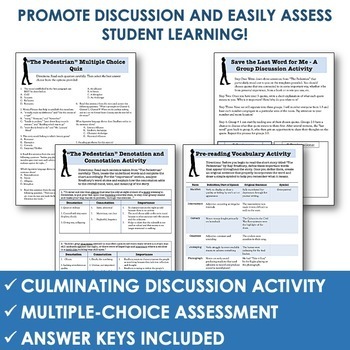
Conduct a close reading of the story as a whole.This 8 question slideshow can be used before reading the short story by Ray Bradbury entitled 'The Pedestrian'. Media File: Poetry: Close ReadingQuestion: Close Reading Response on The Pedestrian Read the short story The Pedestrian by Ray Bradbury. This resource will help you perform a close reading of poetry and begin developing ideas for writing papers based on close readings. In Part 1 students match 10 figurative language terms from a word bank to their definitions: parallel structure, alliteration, synaesthesia, metaphor, simile. The pedestrian by ray bradbury close reading questions Last modified: Monday, 8 October 2012, 9:51 PM This two page worksheet on Ray Bradburys short story, 'The Pedestrian' has 3 parts.
She turned off the lawn mower as he sprinted up to her. IntroductionThe person turned out to be a girl about his age in a grass-stained T-shirt. If you have a Microsoft Account, you can view this file with PowerPoint Online. Students can then make infThis resource is enhanced by a PowerPoint file. You can also have students share out with the whole class.
He has never seen another person out walking during the many hours that he has strolled.Once somewhat ignored in scholarly circles, close reading of poetry is making something of a comeback. Mead is the only pedestrian near his home. Your aim may be to notice all striking features of the text, including rhetorical features, structural elements, cultural references or, your aim may be to notice only selected features of the textfor instance, oppositions and correspondences, or particular historical references.Summary 'The Pedestrian' offers a glance into the future, where a man, Leonard Mead, goes for long walks every evening by himself.The year is 2053, and Mr. You may focus on a particular passage, or on the text as a whole. He wasn’t used to paying attention to the kids around him at When you close read, you observe facts and details about the text. You’re in my homeroom, Max said.
Although you may examine the poem on its own terms, realize that it is connected to the other poems in the cycle.Form is one of the first things you should note about a poem. Performing the close readThe number indicates the sonnet’s place in a cycle or sequence of sonnets. Read the sonnet a few times to get a feel for it and then move down to the close reading.That looks on tempests and is never shaken Whose worth's unknown, although his height be taken.Love's not Time's fool, though rosy lips and cheeksWithin his bending sickle's compass come:Love alters not with his brief hours and weeks,But bears it out even to the edge of doom.I never writ, nor no man ever loved. This resource first presents the entire sonnet and then presents a close reading of the poem below. This close read process can also be used on many different verse forms. You may also increase your ability to write convincingly about the poem.The following exercise uses one of William Shakespeare’s sonnets (#116) as an example.
This is called enjambment, and though it is often made necessary by the form of the verse, it also serves to break up the reader’s expectations. Our first rhyme combination is “minds/finds.” What do you make of this pairing of words?The first phrase (in this case a full sentence) of the poem flows into the next line of the poem. The rhyme of words makes a connection between them.

Also, look at similarity of phrasing between line 9’s “rosy lips and cheeks” and line 11’s “brief hours and weeks.” They certainly rhyme, but how does the similar construction affect the reading?This is our closing couplet (two-line stanza), meant to “resolve” the problem addressed in the poem. Consider how this metaphor relates to the previous ones, and why so much space in the poem is devoted to it, especially as it relates to the poem’s argument. What actual objects do they describe? Do they bear any similarity to each other? Is there a connection between the use of “ever-“ in line 5 and “every” in line seven?The image in lines 5-6 is especially complex: What is the “mark” Shakespeare is talking about and how does it “look?” Answers to some of these questions may require some research into older definitions of words in the Oxford English Dictionary.Our third and final quatrain uses all of its four lines to expand a single metaphor.
Among these possibilities are: Have we seen something similar in the poem before? Where and why are the connections made? From reading to writingThe observations and questions in the close reading notes are by no means complete, but a look over them suggests several possibilities for a paper. Consider also the negations in the final statement. Does it provide resolution or not? Note that the first person (“me/I”) has returned (last seen in the first line of the poem).



 0 kommentar(er)
0 kommentar(er)
